
Page 37: of Marine Technology Magazine (October 2016)
AUV Operations
Read this page in Pdf, Flash or Html5 edition of October 2016 Marine Technology Magazine
the Antarctic and Arctic, where a num- would go on to successfully survey be- the shoulders of the aforementioned gi- ber of major feats were accomplished neath the Pine Island Glacier in Antarc- ants, what will the next generation of including the ? rst multibeam image of tica in 2009. under-ice AUVs look like? the underside of sea-ice, taken off north- No doubt they will be more ef? cient, east Greenland. A major milestone was A Record is Born with new power sources, enabling en- reached in 2005 when the Austosub2 In 2010 International Submarine En- durances beyond the hundreds of kilo- ventured 25km beneath the Fimbul Ice gineering (ISE) once again raised the meters into the thousands of kilometers.
Shelf; an amazing ? rst for an AUV. This bar for distance and endurance in under- They will be more aware of their sur- mission allowed retrieval of data in an ice operations. This time, their Explorer roundings, relying less on pre-scribed environment virtually unreachable by AUV, a 7.4m long, 5,000m depth-rated mission scripts and more on general previous means and yielded the ? rst vehicle, would be tasked with measur- guidelines where the missions can adapt ever image of the shape of the underside ing the topography of Canada’s North- to what is sensed. of an ice shelf, showing a much richer ern continental shelf. Improvements will be seen in how topography that previously thought. Submerged for 12 days, the Explorer they navigate and position themselves,
The Austosub program showed what would conduct three missions: a 320km relying more on perspective observa- was capable with an AUV operating transect departing a near shore ice camp tions of the environment and self-gen- under ice, but also highlighted the real to a remote camp located on an ice ? oe; a erated maps. risks involved: on a follow up mission 280km mission out from and back to the We will see developments into physi- beneath the Fimbul Ice Shelf in Antarc- remote camp; and a 320km return trip. cal interaction, adding to the existing re- tica, the Autosub’s emergency beacon During these missions the AUV would mote sensing capabilities, where physi- was heard, indicating an abort. At a lo- not be recovered, but would instead cal samples may be taken from these cation about 14kms from the edge, the dock at a through-ice capture system de- remote areas.
Autosub-2 was lost. veloped and tested the previous year by Under-ice AUVs will become more
Following the loss, two outcomes Memorial University of Newfoundland. common, and with that, more reliable to emerged. The ? rst was a realization This system would allow the AUV to be the point where their use will be ubiq- that the risks of AUVs operating under held fast, charged and provided with a uitous in the collection of critical data ice need to be better understood. As a wired connection for data exchange. It locked away below the ice. result, a body of work began to emerge also supplied a means to realign the in- We will even see them used in the ice- from Southampton involving much of ternal navigation system. To reach a re- covered oceans of other worlds, such the wider AUV community to try and mote point after such a long journey, a as Jupiter’s moon Europa. (see related model the failures of AUVs. The objec- novel homing system was developed to story on page 22, this edition).
tive was to help predict, or at least quan- allow the AUV to steer toward a single, AMC is establishing an AUV research tify, the potential risk of loss and has low frequency sound source. facility to house a ? eet of AUVs, include bene? ted today’s under-ice operations. a new Explorer class AUV from Interna-
The second outcome was the develop- What’s next? tional Submarine Engineering (ISE) for ment of Autosub-3, a new vehicle that For those of us who hope to stand on under-ice exploration in Polar Regions. www.marinetechnologynews.com
Marine Technology Reporter 37
MTR #8 (34-49).indd 37 9/27/2016 2:44:16 PM

 36
36

 38
38
